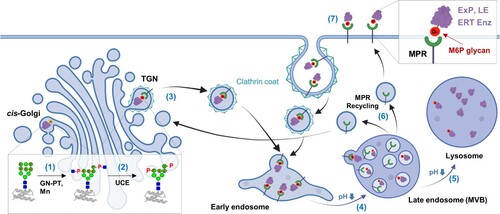Figures & data
Figure 1. Schematic representation of M6P glycan biosynthesis and its role in lysosomal targeting. In the cis-Golgi apparatus, GlcNAc-PT (GN-PT) transfers GlcNAc-1-phosphate to high mannose glycans on LEs, accompanied by mannosidase (Mn) trimming (1). In the TGN, the uncovering enzyme (UCE) removes the outer GlcNAc to generate M6P (2). MPRs at the TGN membrane recognize M6P glycans on LEs, and the LE-MPR complex moves to the early endosome via clathrin-coated vesicles (3). The LE-MPR complex dissociates at the low pH of the late endosome, including the multivesicular body (MVB) (4). The released LEs go to the lysosome (5), whereas the MPRs return to the TGN through the recycling endosome (6). Extracellular proteins (ExP) containing M6P glycans, such as LEs and ERT enzymes, can be taken up by CI-MPR at the plasma membrane through clathrin-mediated endocytosis and delivered to lysosomes via the late endosome (7). Symbols used for glycans are suggested by the Consortium for Functional Glycomics (http://www.functionalglycomics.org/): Green circle, mannose; blue square, GlcNAc; and P, phosphate. This figure was created with BioRender.com. The potential mannose residues for phosphorylation are indicated with an asterisk (*) (Zhu et al. Citation2005).

